A major new facility has opened at BAE Systems’ shipyard in Glasgow, marking a transformative moment for naval construction on the Clyde.
The state-of-the-art shipbuilding hall, officially named the Janet Harvey Hall, will allow two Type 26 frigates to be constructed side by side for the first time fully undercover. It represents the most visible milestone in a £300 million programme to modernise and digitise BAE Systems’ operations on the river.
Shipbuilding returns to the Clyde at scale. The Janet Harvey Hall opens in Govan — a £300m bet on the future of British naval construction, @geoallison was there today to take a look. pic.twitter.com/UfGJ5xDOEO
— UK Defence Journal (@UKDefJournal) June 25, 2025
Rather than BAE Systems or Ministry of Defence officials, it was Janet Harvey’s nieces—joined by the Lord Provost of Glasgow—who cut the ribbon to formally open the hall. The naming honours the legacy of Janet Harvey, one of many women who stepped into industrial roles during the Second World War.
“The Janet Harvey Hall marks a major step forward for shipbuilding in Glasgow and will help enable efficient and safe shipbuilding for decades to come,” said Simon Lister, Managing Director of BAE Systems’ Naval Ships business. “It’s a symbol of pride not just for our skilled workforce who bring these ships to life, but for the entire city.”
With a footprint of 170 metres by 80 metres and internal cranes capable of lifting up to 100 tonnes, the hall is already home to the construction of HMS Belfast and HMS Birmingham. HMS Glasgow and HMS Cardiff are undergoing fit-out at Scotstoun, and steel has been cut on HMS Sheffield.
The facility is designed to house up to 500 workers per shift and shield shipbuilding from the impact of adverse weather. According to BAE Systems, the hall will improve delivery schedules and boost build quality by streamlining the warship assembly process.
“The Janet Harvey Hall brings an improved approach to warship assembly and outfit, driving quality throughout the build,” said Stephen Charlick, Type 26 Resident Project Officer at Defence Equipment and Support. “This approach supports regular delivery of vessels in line with the Royal Navy need.”
The opening of the new hall comes as the Type 26 programme continues to gain momentum, with more than 120 UK suppliers contributing to the eight-ship programme. The vessels will serve the Royal Navy into the 2060s and form a central pillar of the UK’s future surface fleet.
Export interest remains high, with the design already selected by Canada and Australia. Norway is also considering the Type 26 as it evaluates options for its new frigate programme.
Image courtesy of BAE Systems.



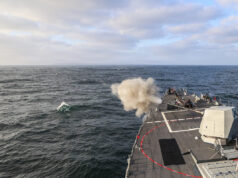
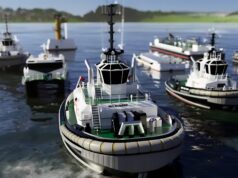
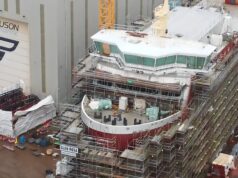
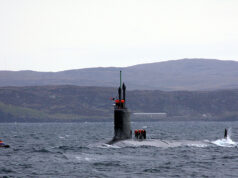
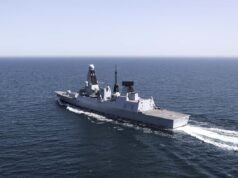

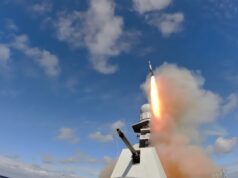
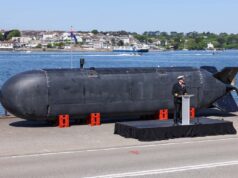
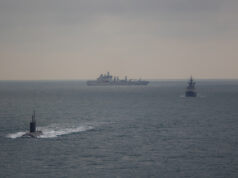
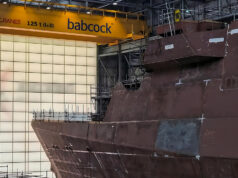

That will improve the hull fabrication process, but now they need to speed up the fitting out in Scotstoun.
I quess not a lot of preoutfitting before lunch, not the most efficient way.
Normally gets done after Dinner.
Yes, Scotstoun now seems to be the bottleneck, particularly if Norway orders 5 T26’s and want the first in service “before the end of the decade”, with the others following at one a year. BAE’s clear inability to contractually commit to that timeline is making the French Naval Group confident that it’s going to win the order, particularly as their FDI design is also much cheaper and they can deliver 6 rather than 5 ships within the NOK75.8 billion budget (£5.5 bn). Either Scotstoun is somehow going have to be upgraded to increase its capacity, or ships rolled out by Govan are going to have to be in a far more advanced state of overall completion than c.50%. Or maybe another shipyard could be added? Barrow is max’ed out on subs, maybe Cammell Laird, or even a yard in Norway?
Naval Group is signing deals left and right with Norwegian companies. A press release dated 26 June states:
“The French naval defense company Naval Group and the Norwegian shipyard Westcon have signed a Memorandum of Understanding (MoU) to develop a long-term strategic cooperation in Norway. This agreement is part of a series of agreements between Naval Group and Norwegian industries to reinforce industrial collaboration in support of the future Norwegian frigate program. It is another concrete step towards securing national maintenance and Through Life Support (TLS) in Norway. The goal is to ensure operational availability of the FDI frigates at a level comparable to that of the French Navy’s FREMM frigates, which have maintained a fleet availability rate above 80%. This agreement is a new stone in the development of a Norwegian maritime and defense cluster meeting our common ambition to develop a sovereign, resilient, and future-ready naval support structure in Norway. To this extent, Naval Group has signed a large number of MoUs and partnership agreements with Norwegian industrial companies and academics (examples: Konsgberg, CCB, Westcon, NORCE, SINTEF, Simula, Akkodis, NTNU), in order to integrate them in the group’s global supply chain.”
A fabulous turn of events brings back echoes of the mighty shipbuilding past. Well done, Scotland and the MOD. I wonder if, in the long term, the first two ships built in the new shed will prove to be more resilient than the two lead ships, which were exposed to the elements during their hull assembly. I know there were some concerns about weld quality using the original set-up?
Hopefully the Welds used on Glasgow and Cardiff met or exceeded the required standards.
There was some talk of warping in the hull joins but it could have been the negative press!
I would have thought…. Well done Bae would be more appropriate. Scotland and the MOD haven’t done anyhthing.
A bit disingenuous, Geoff but you are correct, I should have included BAE.
My aplogies Maurice. Nothing intended. I’m just used to the Scottish goverment moaning about defence all the time.
fabulous news, well overdue it will be interesting as to whether the building hall will be big enough to use for the proposed T83 destroyer build but the ability to build two T26 art the same time is welcome indeed
It is good news taking ship building indoors away from the changeable Scottish weather.
Ermmm, It’s a bigger shed than the old one.
“There’s pictures and everything.”
Serious question.
Do these operate on a 3 or 4-shift system?
So in theory if they really wanted to they could lay down 4 type 26s at a time. 2 in the new shed, 1 in the old shed and one on the hard standing. Infact if Norway does order T26 they will probably need to do something like that.
Great work. Seems like only yesterday we were looking at the photos on here of the cofferdams getting put in and the basin being drained!
Seens rather quick to get to this stage. Or maybe it is just me, and the build has been ongoing for longer.
Assuming more ships get ordered. Canada and Australia are ordering more than us. THere is a theory that if Norway ordres T26 then two of our ships undre construction will go to Norway. We probably need 4 more T26s.
Australia has reduced its order to 6 ships, in favour of a hi/lo mix.
can’t see it the cost of moreT26 won’t allow for it the T73 will have precidence over everything else
Good work by BAE to get the hall built and up and running. Hopefully they’ll be a few more T26s built with a batch 2 RN order and a Norwegian order.
Fantastic, brilliant, well done, amazing job, Can I get the Solar Panel Installation contract please ?
“The Sun never sets on the British Empire”.
I was going to query where those had gone to as they were much trumpeted in the planning stages.
Like many things that will support applications in large development plans they tend to disappear once the building is up…
Yes indeed.
Planning permission is permission to do something.
Unless it is specifically written into the consent that it must be done – then apart from statutory building regs bits then it can often fall by the wayside.
On a roof of that size, the generating potential is massive and with the correct Lithium battery storage, it would provide a huge amount of power.
We need to email China to see if they can fire up a few more Coal powered stations so they can manufacture all the Panels and batteries for this “Eco Friendly” project.
I shit you not, that’s the way it works.
Mind you will Millibrain’s planned power cuts those solar panels might be more useful for keeping the lights on.
I totally agree that making ‘green’ solar panels with poor/zero environmental controls is insanity.
We can only dream of their green energy projects sadly.
My concern is the future T83. will the build hall be big enough. At the moment modern AAW destroyers are coming in at about 8,500 -12,000 tons and 160-180m
It’s still too early to know what the Type 83 will end up being, but if it is a 10,000+ ton Ship and like the Type 26 is basically built in two halves, as long as the Joining process can be done inside there shouldn’t be any issues.
Ahh but they thought of that too. You can build two 180m ships by positioning them corner to corner.
“Behold the X Craft.”
Also, any future Australian T83’s can be built curved.
“Behold the Boomerang class”.
As a neat accompaniment to Craig’s article above, NL has just published an in-depth look at the progress in fitting out HMS Glasgow.
Okay, now let’s make the next one in the North East of England.
Just thinking out loud. Are our RN shipbuilding assets concentrated all in one place & not dispersed out across UK. So would be an easy target in any major future conflict.